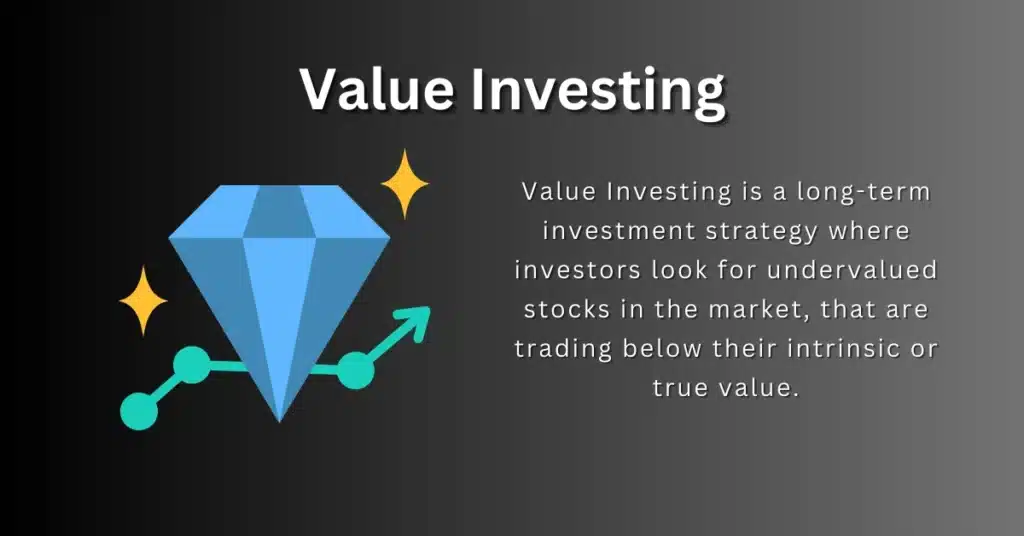Value investing in the Indian stock market or any other stock market is a time-tested approach that has helped countless investors achieve financial success.
This investment philosophy, popularized by legendary investors like Warren Buffett and Benjamin Graham, revolves around the idea of buying undervalued assets and holding them for the long term.
Here, we’ll break down what value investing is all about in simple terms and explain why it’s a valuable approach for anyone looking to grow their money wisely.
What is Value Investing In India?
Value investing in India is like shopping for discounts in the stock market. Imagine you’re at a store, and you see a high-quality product on sale for a price lower than its actual worth. You’d probably buy it, right? Well, value investors do something similar in the stock market.
They look for companies whose stock prices are lower than what they believe the company is truly worth. These investors believe that, over time, the market will recognize the true value of these stocks, and their prices will rise.
So, they buy these undervalued stocks, hold onto them patiently, and wait for their investments to grow.
The Origins of Value Investing: A Historical Perspective
Value investing has long been regarded as a timeless strategy for wealth creation. But have you ever wondered how this investment philosophy got its start? Let’s embark on a journey through time to explore the fascinating history of value investing.
The Birth of Value Investing
The story begins in the early 20th century, with a man named Benjamin Graham. Born in 1894, Graham would become known as the “Father of Value Investing.”
He was a professor at Columbia Business School and authored the groundbreaking book “Security Analysis” in 1934, along with David Dodd. This book laid the foundation for value investing as we know it today.
Graham’s core idea was simple: buy stocks of companies that are trading for less than their intrinsic value. In other words, he believed in purchasing stocks when they were undervalued by the market.
This concept went against the prevailing investing philosophy of the time, which emphasized rapid speculation and often ignored the true worth of companies.
The Margin of Safety
One of Benjamin Graham’s most famous concepts is the “margin of safety.” This principle advises investors to buy stocks at a significant discount to their intrinsic value to protect against potential losses.
It’s akin to buying a dollar for fifty cents, ensuring that even if the market fluctuates, you’re less likely to lose money.
Value Investing from Graham to Buffett and beyond
Benjamin Graham’s teachings didn’t stop with his books. His ideas inspired a young Warren Buffett, who would later become one of the most successful investors in history.
Buffett, often called the “Oracle of Omaha,” adopted Graham’s principles and developed them further.
Buffett’s investment philosophy is closely aligned with Graham’s, emphasizing long-term thinking, patience, and a thorough analysis of a company’s fundamentals.
His success in applying these principles made him a household name and a symbol of value investing’s enduring power.
The Evolution of Value Investing
While the core principles of value investing remain unchanged, the investing landscape has evolved. Modern technology has made it easier for investors to access information and conduct research.
However, the essence of value investing — identifying undervalued stocks with a margin of safety — remains as relevant today as it was in Benjamin Graham’s time.
The Key Principles of Value Investing
Value investing is built upon several fundamental principles that guide investment decisions:
1. Intrinsic Value:
Value investors determine a company’s intrinsic value, which is the real or fair value of the company’s stock. Investors aim to buy assets when they are trading below their intrinsic value.
They use various methods like analyzing financial statements, cash flows, and growth prospects to calculate this value.
2. Margin of Safety:
To reduce risks, value investors insist on a “margin of safety.” This means they buy stocks at prices significantly lower than their calculated intrinsic value. It’s like buying that discounted product with even more savings.
3. Long-Term Perspective:
Value investing is not a get-rich-quick scheme. Investors who follow this strategy typically hold onto their investments for the long term, often years or even decades.
They focus on the fundamental value of an asset rather than short-term price fluctuations.
4. Quality Matters:
Value investors prefer companies with strong fundamentals, like a history of profitability, manageable debt levels, and competitive advantages in their industry.
5. Contrarian Thinking:
Value investors often go against the crowd. They look for opportunities when others are fearful, and they sell when the market becomes exuberant.
Techniques for Identifying Value Investments
Now that we’ve explored the core principles of value investing, let’s delve into the techniques used to identify potential value investments:
A. Fundamental Analysis:
This involves a deep dive into a company’s financial statements, assessing factors like revenue, earnings, and debt.
Read | How to Conduct Fundamental Analysis for Stock Selection: 10 key points
Value investors analyze metrics such as price-to-earnings (P/E) ratio, price-to-book (P/B) ratio, and dividend yield to determine if a stock is undervalued.
B. Economic Moats:
A company’s competitive advantage, often referred to as an economic moat, is crucial for long-term value.
Businesses with strong moats can maintain profitability and withstand competition.
C. Qualitative Analysis:
Beyond financial metrics, value investors consider qualitative factors like the quality of management, industry dynamics, and a company’s growth potential.
D. Stock Screeners:
Various online tools and platforms allow investors to screen stocks based on specific criteria. These screeners can help identify undervalued stocks that fit your investment strategy.
What makes a great value stock?
A great value stock possesses certain characteristics that make it an attractive investment for value investors.
These characteristics reflect the underlying fundamentals of the company and its stock price, and they are used to identify stocks that are considered undervalued.
Here are some key attributes of a great-value stock:
Low Valuation Ratios:
Value stocks typically have lower valuation ratios compared to the broader market. Some common valuation metrics include:
Price-to-Earnings (P/E) Ratio:
A low P/E ratio suggests that the stock is priced lower relative to its earnings. This is a classic indicator of value.
Price-to-Book (P/B) Ratio:
A low P/B ratio indicates that the stock is trading below its book value, which represents the net assets of the company.
Price-to-Sales (P/S) Ratio:
A low P/S ratio suggests that the stock is trading at a lower multiple of its sales, indicating potential undervaluation.
Strong Fundamentals:
A great value stock is typically associated with a company that has solid financial fundamentals. Key fundamental factors include:
Stable Earnings:
The company should have a consistent track record of earnings or, at the very least, a clear path to future profitability.
Healthy Balance Sheet:
A low debt-to-equity ratio and ample liquidity are signs of a strong balance sheet, reducing financial risk.
Positive Cash Flow:
A positive and consistent cash flow indicates that the company can meet its financial obligations and reinvest in the business.
Dividend Yield:
Many value stocks pay dividends, providing investors with a regular income stream.
A healthy dividend yield, especially when compared to the industry average or historical yield of the stock, can be an attractive feature for value investors.
The margin of Safety:
Value investors look for a “margin of safety.” This means that the stock’s price is significantly below its intrinsic or fair value. This cushion reduces the risk of substantial loss.
Stable Business Model:
Companies with predictable and stable business models are often preferred by value investors. These businesses are less prone to rapid changes in their industry or market.
Market Mispricing:
A great value stock is often one that the market has undervalued due to short-term issues, temporary setbacks, or broader market sentiment.
Value investors seek opportunities where the market’s perception doesn’t align with the underlying fundamentals.
Management Quality:
Strong, competent, and shareholder-friendly management teams are crucial.
Value investors prefer companies with leaders who prioritize shareholder interests and make sound capital allocation decisions.
Diversification:
Building a diversified portfolio of value stocks across different sectors and industries can help spread risk and reduce the impact of a poor-performing stock.
Patience:
Value investing requires patience. A great value stock may take time to appreciate its intrinsic value, and investors need to be prepared to hold their positions for the long term.
Growth vs. Value Investing
| Aspect | Growth Investing | Value Investing |
|---|---|---|
| Investment Approach | Seeks companies with high growth potential, often in emerging industries or with innovative products/services. | Seeks undervalued companies trading below their intrinsic value, often in mature or traditional industries. |
| Focus | Emphasizes capital appreciation and expects stock prices to increase substantially over time. | Emphasizes capital preservation and seeks stocks with lower price-to-earnings (P/E) ratios and higher dividend yields. |
| Risk Tolerance | Typically involves higher volatility and greater risk due to the potential for stock prices to fluctuate widely. | Generally considered less risky because investments are made in companies with established track records and lower valuations. |
| Dividends | Growth companies may reinvest profits into expansion, so they may not pay dividends or offer low yields. | Value companies often pay dividends, providing a steady income stream for investors. |
| Examples | Tech startups, biotech firms, companies in high-growth sectors like e-commerce and renewable energy. | Established companies in industries like utilities, healthcare, and manufacturing. |
| Valuation Metrics | Focuses on metrics like price-to-earnings growth (PEG) ratio and forward P/E ratio to justify higher valuations. | Emphasizes metrics like price-to-earnings (P/E) ratio, price-to-book (P/B) ratio, and dividend yield to identify undervalued stocks. |
| Market Sentiment | Often attracts investors during bull markets and periods of economic optimism. | Attracts investors during bear markets and economic downturns when safety and stability are prioritized. |
Why Value Investing Makes Sense
Now, you might be wondering why value investing is a good idea. Here are some reasons:
1. Lower Risk:
By buying stocks with a margin of safety, value investors reduce the risk of losing their investment capital.
Even if a stock price fluctuates in the short term, the underlying value should provide stability over time.
2. Consistent Returns:
Value investing has a track record of delivering consistent returns over the long haul. Patient investors often see their investments grow steadily.
3. Simplicity:
Value investing is straightforward and doesn’t require you to constantly monitor the stock market. It’s a methodical approach that doesn’t require you to be a financial genius.
Most famous value investors
Several famous value investors have made a significant impact on the world of finance through their investment philosophies and track records of success. Here are some of the most famous value investors:
Benjamin Graham:
Often referred to as the “Father of Value Investing,” Benjamin Graham’s teachings laid the foundation for value investing.
His books, including “Security Analysis” and “The Intelligent Investor,” are considered classics in the field. Graham’s most famous disciple was Warren Buffett.
Warren Buffett:
Warren Buffett is perhaps the most well-known value investor of all time. He is the chairman and CEO of Berkshire Hathaway, a conglomerate holding company.
Buffett’s investment approach emphasizes buying undervalued companies with strong competitive advantages and holding them for the long term.
His annual shareholder letters are widely read and highly regarded in the investment community.
Charlie Munger:
Charlie Munger is Warren Buffett’s longtime business partner and vice chairman of Berkshire Hathaway. He is known for his sharp wit and is often seen as Buffett’s intellectual counterpart.
Munger’s investment philosophy aligns closely with Buffett’s, emphasizing quality businesses at reasonable prices.
Seth Klarman:
Seth Klarman is the founder of the Baupost Group, a highly successful hedge fund known for its value-oriented approach.
Klarman is considered one of the most successful value investors of his generation. He is known for his disciplined and patient investment style.
Joel Greenblatt:
Joel Greenblatt is an accomplished value investor and author. He is known for his investment strategy outlined in the book “The Little Book That Beats the Market,” which focuses on buying stocks with high earnings yields and strong return on capital.
Howard Marks:
Howard Marks is the co-founder and co-chairman of Oaktree Capital Management, a prominent investment firm known for distressed debt investing.
Marks is known for his insightful memos to clients, which provide valuable perspectives on the market and investing.
Mohnish Pabrai:
Mohnish Pabrai is an Indian-American investor and managing partner of Pabrai Investment Funds.
He is known for his deep value investing approach, often modeling his investments after Warren Buffett’s principles.
Irving Kahn:
Irving Kahn was one of the oldest and most respected value investors before his passing in 2015.
He worked closely with Benjamin Graham and co-founded the Kahn Brothers Group, an investment firm known for its conservative, value-oriented approach.
David Einhorn:
David Einhorn is the founder and president of Greenlight Capital, a prominent hedge fund.
He gained fame for his successful short-selling bets and value investing approach, which often involves a focus on the intrinsic value of companies.
Criticism of value investing
Value investing, despite its many proponents and success stories, has faced criticism and skepticism over the years. Here are some common criticisms of value investing:
Market Efficiency Hypothesis: Critics argue that markets are mostly efficient, meaning that stock prices already reflect all available information.
Therefore, they believe it is challenging to consistently identify undervalued stocks that can outperform the market.
Value Traps: One of the significant criticisms of value investing is the risk of investing in so-called “value traps.”
These are stocks that appear undervalued but continue to decline or never recover because the underlying companies face long-term challenges.
Changing Business Dynamics: Critics contend that the nature of businesses has changed, with many companies now relying more on intangible assets like intellectual property and brand recognition. This shift may make traditional valuation methods less relevant.
Psychological Bias: Value investing can be emotionally challenging, as it often requires contrarian thinking. Critics argue that human psychological biases, such as herd behavior and loss aversion, can make it difficult for investors to stick with value strategies during challenging times.
Lack of Diversification: Value investors may concentrate their portfolios on a limited number of stocks or sectors, potentially increasing the risk associated with individual stock picks.
Value vs. Growth Cycles: Value investing tends to perform better during certain market cycles, while growth stocks may outperform during others.
Critics argue that value investing’s success can be cyclical and not suitable for all market conditions.
FAQs: Value Investing
Q1: What is value investing?
Value investing is a strategy where you buy stocks or assets that are undervalued, expecting them to rise in price as their real worth becomes recognized by the market.
Q2: What is an example of value investment?
An example is buying shares of a financially stable company when their stock price is lower than what their fundamentals suggest.
Q3: What is Warren Buffett’s value investing?
Buffett’s approach is about investing in strong companies with competitive advantages when they are priced attractively for the long term.
Q4: Is value investing good for beginners?
Yes, if beginners are willing to research, hold stocks for the long term, and exercise patience.
Q5: How can investing in value stocks make you richer?
By buying undervalued stocks, you can profit as their prices rise over time, potentially leading to higher wealth.
Q6: Why invest in value stocks?
Investing in value stocks minimizes the risk of overpaying for assets and aligns with buying low and selling high.
Q7: Is value investing right for you?
Value investing suits patient, long-term investors who can withstand market fluctuations. Assess your financial goals and consult an advisor for guidance.
Final Thoughts
In simple terms, value investing is like buying discounted goods in the stock market. It’s about finding stocks that are priced below their actual worth, with a focus on quality and a long-term perspective.
By following these principles, value investors aim to grow their wealth steadily and with lower risk.
So, if you’re looking to invest your money wisely, consider giving value investing a try—it might be the key to your financial success.



